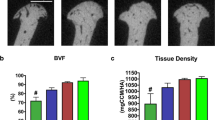Abstract
Human laryngeal cartilages, especially thyroid cartilage, exhibit gender-specific ageing. In contrast to male thyroid cartilages, the ventral half of the female thyroid cartilage plate remains unmineralized until advanced age. In cartilage specimens from laryngectomies and autopsies, apoptosis was studied immunohistochemically and the oxidative mitochondrial enzyme nicotinamide adenine dinucleotide hydride tetrazolium reductase (NADH-TR) was localized histochemically. In addition, very fresh specimens from laryngectomies were fixed under addition of ruthenium hexamine trichloride or tannin to fixation solution to study cell organelles of chondrocytes by electron microscopic methods. In general, apoptotic chondrocytes decreased in thyroid cartilages of both genders, especially after the second decade. In the age group 41–60 years, thyroid cartilage from male specimens revealed a significantly higher percentage of apoptotic cells than did thyroid cartilage from women (P = 0.004), whereas in the age groups 0–20 years and 61–79 years no statistically significant gender difference was determined. In general, thyroid cartilage from women contained more living chondrocytes into advanced age than men. Chondrocytes adjacent to mineralized cartilage were partly positive for apoptosis and NADH-TR and partly negative. Apoptotic chondrocytes often were localized in areas of asbestoid fibres where vascularization and mineralization took place first. Electron microscopy revealed remnants of chondrocytes in asbestoid fibres. Taken together, it can be assumed that some chondrocytes in thyroid cartilage die by apoptosis and that these chondrocytes are characterized by absent reactivity for the mitochondrial enzyme NADH-TR. A possible influence of sexual hormones on apoptotic death of thyroid cartilage cells requires further elucidation.





Similar content being viewed by others
References
Adams CS, Shapiro IM (2002) The fate of the terminally differentiated chondrocyte: evidence for microenvironmental regulation of chondrocyte apoptosis. Crit Rev Oral Biol Med 13:465–473
Blanco FJ, Lopez-Armada MJ, Maneiro E (2004) Mitochondrial dysfunction in osteoarthritis. Mitochondrion 4:715–728
Bonucci E, Cuicchio M, Dearden LC (1974) Investigations of ageing in costal and tracheal cartilage of rats. Z Zellforsch 147:505–527
Chagin AS, Chrysis D, Takigawa M, Ritzen EM (2006) Locally produced estrogen promotes fetal rat metatarsal bone growth; an effect mediated through increased chondrocyte proliferation and decreased apoptosis. J Endocrinol 188:193–203
Chrysis D, Nilsson O, Ritzen EM, Savendahl L (2002) Apoptosis is developmentally regulated in rat growth plate. Endocr 18:271–278
Claassen H, Kirsch T (1994) Immunolocalization of type X collagen before and after mineralization of human thyroid cartilage. Histochemistry 101:27–32
Claassen H, Werner JA (1992) Fiber differentiation of the human laryngeal muscles using the inhibition reactivation myofibrillar ATPase technique. Anat Embryol 186:341–346
Claassen H, Werner J (2004) Gender-specific distribution of glycosaminoglycans during cartilage mineralization of human thyroid cartilage. J Anat 205:371–380
Dearden LC, Bonucci E, Cuicchio M (1974) An investigation of ageing in human costal cartilage. Cell Tiss Res 152:305–337
Eggli PS, Herrmann W, Hunziker EB, Schenk RK (1985) Matrix compartments in the growth plate of the proximal tibia of rats. Anat Rec 211:246–257
Garimella R, Bi X, Camacho N, Sipe JB, Anderson HC (2004) Primary culture of rat growth plate chondrocytes: an in vitro model of growth plate histotype, matrix vesicle biogenesis and mineralization. Bone 34:961–970
Gibson G (1998) Active role of chondrocyte apoptosis in endochondral ossification. Microsc Res Tech 43:191–204
Habermann G (1996) Stimme und Mensch. Median-Verlag GmbH
Hatori M, Klatte KJ, Teixeira CC, Shapiro IM (1995) End labeling studies of fragmented DNA in the avian growth plate: evidence of apoptosis in terminally differentiated chondrocytes. J Bone Miner Res 10:1960–1968
Horton WE, Feng L, Adams C (1998) Chondrocyte apoptosis in development, aging and disease. Matrix Biol 17:107–115
Hunziker EB, Herrmann W, Schenk RK (1982) Improved cartilage fixation by ruthenium hexammine trichloride (RHT). A prerequisite for morphometry in growth cartilage. J Ultrastruct Res 81:1–12
Jarvinen M, Jozsa L, Hurme M, Einola S (1989) Histological and enzyme histochemical study on the injured knee meniscus in human. Acta Histochem 85:9–14
Kakuta S, Golub EE, Haselgrove JC, Chance B, Frasca P, Shapiro IM (1986) Redox studies of the epiphyseal growth plate cartilage: pyridine nucleotide metabolism and the development of mineralization. J Bone Miner Res 1:433–440
Köpf-Maier P, Merker HJ (1989) Atlas der Elektronenmikroskopie. Ueberreuter Wissenschaft, Wien
Lojda Z, Gossrau R, Schiebler TH (1976) Enzymhistochemische Methoden. Springer, Berlin
Maneiro E, Martin MA, de Andres MC, Lopez-Armada MJ, Fernandez-Sueiro JL, del Hoyo P, Galdo F, Arenas J, Blanco FJ (2003) Mitochondrial respiratory activity is altered in osteoarthritic human articular chondrocytes. Arthritis Rheum 48:700–708
Nahir AM, Vitis N, Silbermann M (1990) Cellular enzymatic activities in the articular cartilage of osteoarthritic and osteoporotic hip joints of humans: a quantitative cytochemical study. Aging 2:363–369
Nahir AM, Shomrat D, Awad M (1995) Differential decline of rabbit chondrocytic dehydrogenases with age. Int J Exp Pathol 76:97–101
Person P, Fine A (1959) Oxidative metabolism in cartilage. Nature 183:610–611
Ploumis A, Manthou ME, Emmanouil-Nikolousi EN, Sofia A, Christodoulou A (2004) Animal model of chondrocyte apoptosis in the epiphyseal cartilage of the neonatal bone. J Orthop Sci 9:495–502
Shapiro IM, Golub EE, Kakuta S, Hazelgrove J, Havery J, Chance B, Frasca P (1982) Initiation of endochondral calcification is related to changes in the redox state of hypertrophic chondrocytes. Science 217:950–952
Shapiro IM, Adams CS, Freeman T, Srinivas V (2005) Fate of the hypertrophic chondrocyte: microenvironmental perspectives on apoptosis and survival in the epiphyseal growth plate. Birth Defects Res C Embryo Today 75:330–339
Whitehead RG, Weidmann SM (1959) Oxidative enzyme systems in ossifying cartilage. Biochem J 72:667–672
Wyllie AH (1992) Apoptosis and the regulation of cell numbers in normal and neoplastic tissues: an overview. Cancer Metast Rev 11:95–103
Zhang X, Huang H, McDaniel GR, Giambrone JJ (1997) Comparison of several enzymes between normal physeal and tibial dyschondroplastic cartilage of broiler chickens. Avian Dis 41:330–334
Acknowledgments
We would like to thank Ms. A. Haupt and Ms. E. Schöngarth (Anatomical Institute Kiel) for their excellent assistance during the experiments.
Author information
Authors and Affiliations
Corresponding author
Rights and permissions
About this article
Cite this article
Claassen, H., Schicht, M., Sel, S. et al. The fate of chondrocytes during ageing of human thyroid cartilage. Histochem Cell Biol 131, 605–614 (2009). https://doi.org/10.1007/s00418-009-0569-1
Accepted:
Published:
Issue Date:
DOI: https://doi.org/10.1007/s00418-009-0569-1




